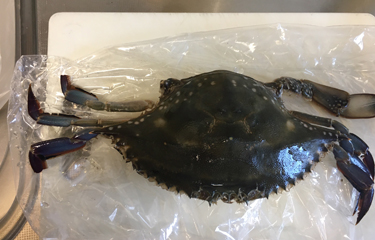The seafood-adoring nation of Japan certainly loves its crab.
Japanese Customs data for year 2019 shows that a total of 2,095,285 kilograms of frozen swimming crab (Portunus sp.) was imported. There is not a separate category for Callinectes species, which would cover the Atlantic blue crab. Instead, any imports in that genus would fall into “Crabs, other.” Picked or canned meat would also be separately listed. However, the frozen whole form is popular in Japan.
The top supplier of Portunus species was Bahrain with 1,174,017 kilograms, and that country’s biggest supplier is Jaradah Blue Crab Factory. China comes in second at 636,570 kilograms, and trailing far behind are Myanmar (95,180 kilograms), Tunisia (75,000 kilograms), Vietnam (37,635 kilograms), and South Korea (21,420 kilograms).
Tunisia lies outside the natural range of the two species common in the Japanese market – the “gazami” crab (Portunus trituberculatus) and the blue swimming crab (Portunus armatus, also called Portunus pelagicus). However, the former was introduced to the Mediterranean as an invasive species, probably in ships’ ballast water, and after being considered a pest, has become the basis for a commercial fishery. A U.S. company, Carthage Crabs, based in Marlboro, New Jersey, U.S.A., is a leader in promoting export of the product. In September, Carthage Crabs created a joint venture with Azzure Mar Seafood Products, LLC, based in Miami, Florida, U.S.A., to supply the U.S. market.
Greece is commercializing invasive Chesapeake blue crab in the same way that Tunisia has done with the blue swimming crab. Exporters include Visvas Ltd. of Thessaloniki and Blue Crab P.C. of Chalastra.
The gazami crab and the blue swimming crab have a similar appearance, and are most easily identified by the different number of points on the carapace, with three for P. trituberculatus and four for P. armatus. The gazami crab (also commonly called “watarigani”) is found off the coasts of Japan, Korea, China, Palau, and Taiwan. It is the world's most heavily-fished crab species, with more than 300,000 metric tons being caught annually, 98 percent of which is caught off the coast of China. Portuna armatus is found in a more southerly range covering the Indian Ocean, Western Australia, and Southeast Asia, reaching to the southern parts of Japan.
China also catches some other similar species: the three-spot swimming crab (Portunus sanguinolentus) that appears in the Japanese market, and the red swimming crab (Portunus haanii).
Armatus is also heavily imported to the U.S.A., where it – and other Portunus species – sometimes substitute for Chesapeake blue crab (Callinectes sapidus) in crab cakes, though it is generally considered less flavorful. Washington, D.C.-based NGO Oceana reported in 2015 that 38 percent of crab cakes it sampled in the Maryland and D.C. area represented by restaurants as Chesapeake blue crab were actually Portunus species. Because the Chesapeake blue crab is always in high demand in the U.S., it does not have a significant presence in the Japanese market.
One notable opening for the species: At least one shipment of Chesapeake blue crab (Callinectes sapidus) from Venezuela has gone to South Korea. Venezuelan exporters include Aqua Farm Del Lago C.A., which mainly ships to Aquafarm U.S.A. through Port Everglades, Florida, U.S.A.; and Procesadora Aqa Mar S.A. in Zulia. Colombia is also an emerging source.
Thailand, Vietnam, Sri Lanka, the Philippines, and Indonesia are the major suppliers of P. armatus to the U.S.A. Overfishing in these areas – responding to U.S. demand after the collapse of the Chesapeake Bay stock – resulted in smaller crabs with lower market value, and prompted U.S. importers to form the National Fisheries Institute (NFI) Crab Council. This organization self-assesses its members based on the tonnage imported and uses the money to sponsor fishery improvement projects (FIPs), including studies on the effectiveness of hatchery releases for restocking, though it aims to stay away from hatchery programs that are “put and take” systems like the Japanese continuous hatchery supplementation in the Seto Inland Sea, on the basis that there is scant evidence such programs result in a restoration of the naturally breeding stock.
The stock in Japan’s Ariake Sea in Southern Kyushu is also in decline, resulting in an Ariake Sea Gazami Wide Area Resource Management Policy being developed in 2018. This plan aimed to supplement the existing protection of egg-bearing crabs and small crabs, re-releases for restocking, and setting of a catch prohibition period. Most crabs in this area are landed live in the local market and shipped to supermarkets and restaurants. Live crabs sell at a premium. Consumption is mostly within the prefectures surrounding this sea (70 percent) and the neighboring prefectures (30 percent). Local crabs are branded under the names "Saki crab," "Ariake gane" and "Taira gane." (“Kani” or “gani” means “crab.”)
The price of blue crab depends on size – the bigger, the better – and on the hardness of the shell. A hard-shelled crab has not recently molted and is likely to be full of meat. Prices are highest at the end of the year. Males are more expensive in summer and females in winter, when females with lots of eggs (uchiko) are prized. The main cooking methods are boiling, steaming (usually served with the green guts called “kanimiso”) and in miso soup.
Dancing Crab, with shops in Tokyo, Osaka and Fukuoka, offers crab cakes. The chain is based in Singapore, and is part of the TungLok Group. It also has a shop in Taipei, Taiwan. The chain has a Louisiana Cajun theme that includes eating directly from the table, and while it may represent the best bet for finding Chesapeake blue crab in Japan, it actually comes from Namibia, a store employee told SeafoodSource.
Photo courtesy of Chris Loew/SeafoodSource







